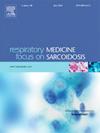有症状但肺活量正常的成年人弥散能力受损与慢性阻塞性肺病发病率。
IF 3.5
3区 医学
Q2 CARDIAC & CARDIOVASCULAR SYSTEMS
引用次数: 0
摘要
背景:有人提出,在没有支气管扩张剂(BD)后气流阻塞的情况下,肺弥散容量(DLCO)受损是 "慢性阻塞性肺病前期 "的标志。然而,DLCO受损与随后的肺功能下降和慢性阻塞性肺病发病率之间的关系尚未得到深入研究:我们对 2014 年至 2024 年期间在澳大利亚一家多中心肺功能实验室接受评估的 40 岁至 70 岁的成年人进行了一项观察性研究。研究纳入了有呼吸道症状或临床怀疑患有阻塞性气道疾病,并在初次评估后≥12个月进行了肺活量随访的成年人。在基线肺活量正常的患者中,评估了DLCO受损与随后肺功能下降和慢性阻塞性肺病发病率之间的关系:中位随访 2.3 [IQR 1.5 至 3.3] 年后,共对 266 名平均年龄为 53.2 (SD 12.8) 岁的患者进行了评估。我们没有发现证据表明 DLCO 受损(低于正常下限)与 BD 后 FEV1(MD -0.1% 预测值/年,95%CI -1.3-1.2)、FVC(-0.4% 预测值/年,95%CI -1.6-0.8)或 FEV1/FVC (-0.1%预测值/年,95%CI -0.1-0.1)的年下降率之间存在关联。DLCO受损对慢性阻塞性肺病发病率的敏感性为40%,特异性为82%。在仅限于当前吸烟者和曾经吸烟者的子样本中,以及在将DLCO受损定义为预测值<80%时,结果相似:结论:在这个真实世界的队列中,受损的 DLCO 并不是肺功能下降或慢性阻塞性肺病发病率的有效判别指标。本文章由计算机程序翻译,如有差异,请以英文原文为准。
Impaired diffusing capacity and COPD incidence in adults with symptoms and normal spirometry
Background
Impaired diffusing capacity of the lung (DLCO) in the absence of post-bronchodilator (BD) airflow obstruction has been proposed as a marker of ‘Pre-COPD’. However, the relationship between impaired DLCO and subsequent lung function decline and COPD incidence has not been examined in-depth.
Methods
We conducted an observational study of adults aged between 40 and 70 years who were evaluated at a multi-centre lung function laboratory in Australia between 2014 and 2024. Adults referred with respiratory symptoms or a clinical suspicion of obstructive airways disease with follow-up spirometry obtained ≥12 months after the initial assessment were included. The relationship between impaired DLCO and subsequent lung function decline and COPD incidence was assessed among those with normal spirometry at baseline.
Results
A total of 266 patients with a mean age of 53.2 (SD 12.8) years were evaluated after a median follow-up of 2.3 [IQR 1.5 to 3.3] years. We found no evidence of an association between impaired DLCO (below the lower limit of normal) and annualised rate of decline in post-BD FEV1 (MD -0.1 % predicted per-year, 95%CI -1.3 to 1.2), FVC (−0.4 % predicted, 95%CI -1.6 to 0.8) or FEV1/FVC (−0.1 % per-year, 95%CI -0.1 to 0.1). The sensitivity of impaired DLCO for COPD incidence was 40 %, and specificity 82 %. Findings were similar in sub-samples limited to current and former smokers, and when impaired DLCO was defined as < 80 % predicted.
Conclusion
Impaired DLCO was not an effective discriminator of lung function decline or COPD incidence in this real-world cohort.
求助全文
通过发布文献求助,成功后即可免费获取论文全文。
去求助
来源期刊

Respiratory medicine
医学-呼吸系统
CiteScore
7.50
自引率
0.00%
发文量
199
审稿时长
38 days
期刊介绍:
Respiratory Medicine is an internationally-renowned journal devoted to the rapid publication of clinically-relevant respiratory medicine research. It combines cutting-edge original research with state-of-the-art reviews dealing with all aspects of respiratory diseases and therapeutic interventions. Topics include adult and paediatric medicine, epidemiology, immunology and cell biology, physiology, occupational disorders, and the role of allergens and pollutants.
Respiratory Medicine is increasingly the journal of choice for publication of phased trial work, commenting on effectiveness, dosage and methods of action.
 求助内容:
求助内容: 应助结果提醒方式:
应助结果提醒方式:


